HND Business Unit 6: Managing a Successful Business Project - Report
VerifiedAdded on 2022/12/27
|19
|2984
|63
Report
AI Summary
This report presents a business project focusing on talent management strategies, using Halfords as the case study. The project establishes aims and objectives, creates a project management plan, and develops a work breakdown structure. It incorporates both primary research, using questionnaires to gather employee insights, and secondary research, drawing on existing literature and expert opinions. The findings and data are presented using pie charts, and recommendations are provided to Halfords' management. The report concludes with a reflection on the learning experience gained throughout the project, emphasizing the importance of a well-defined process. The report is written as part of the HND Business course at Nelson College London and follows a formal business report structure, including an introduction, main body, conclusion, and references, ensuring the use of Harvard referencing.
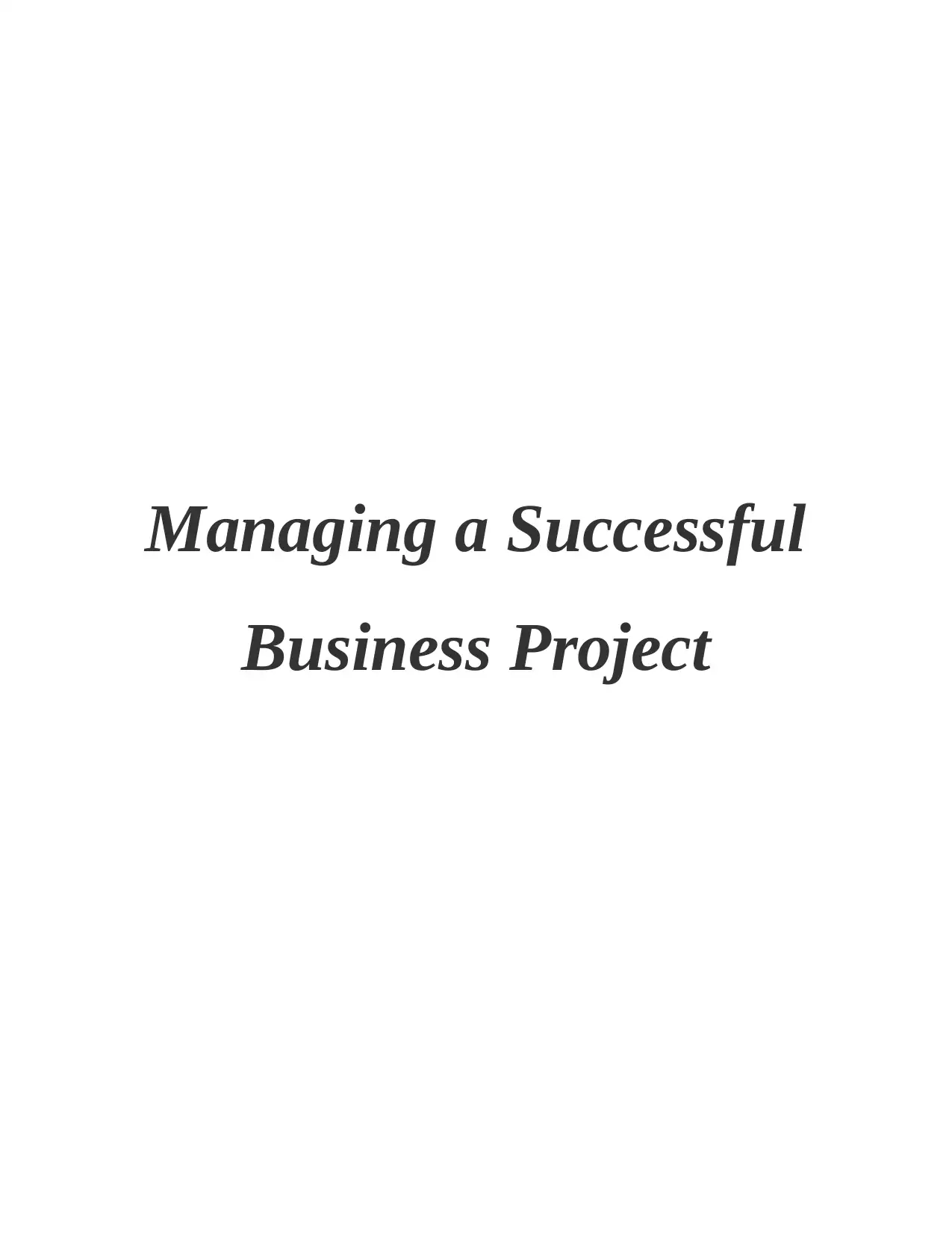
Managing a Successful
Business Project
Business Project
Paraphrase This Document
Need a fresh take? Get an instant paraphrase of this document with our AI Paraphraser
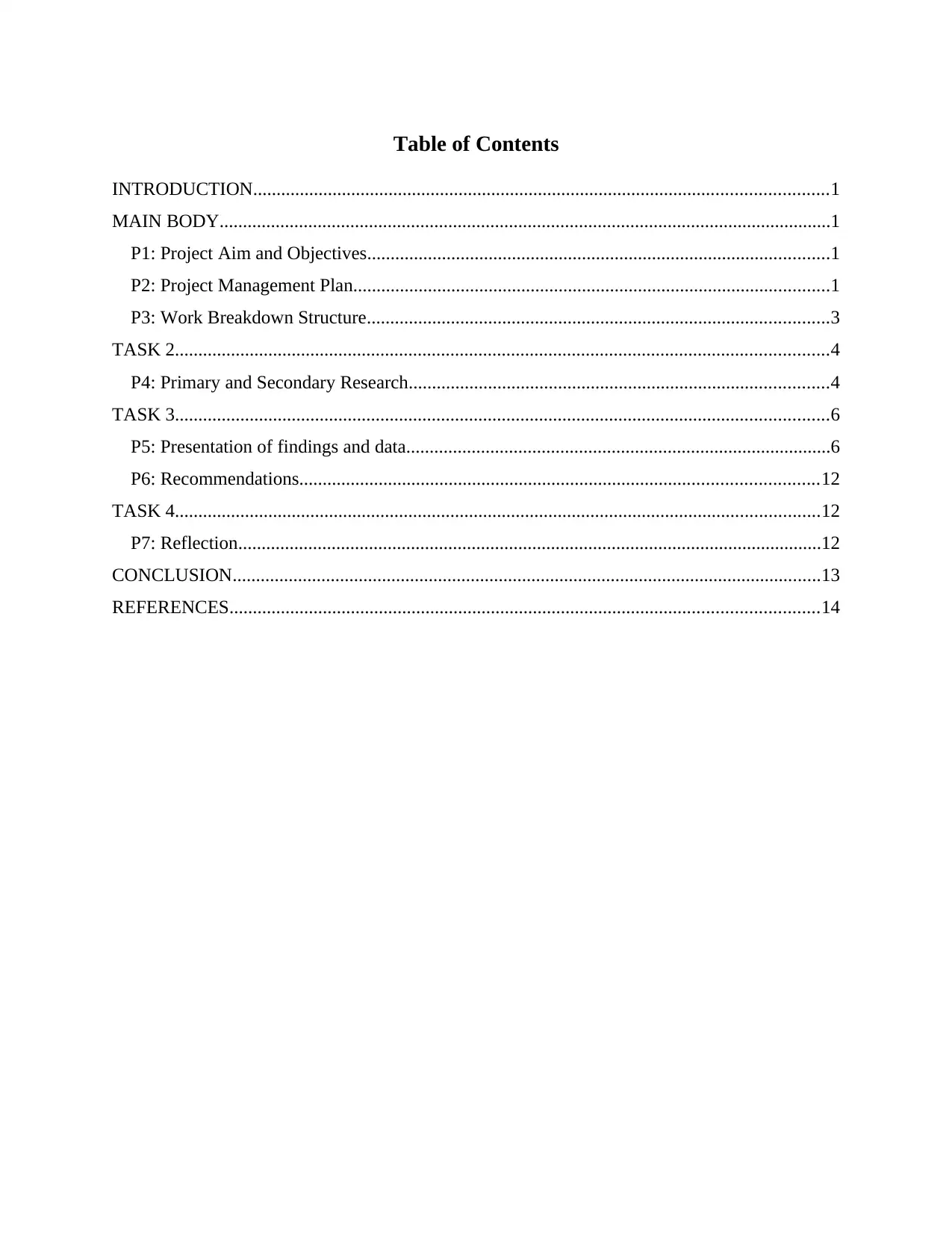
Table of Contents
INTRODUCTION...........................................................................................................................1
MAIN BODY...................................................................................................................................1
P1: Project Aim and Objectives...................................................................................................1
P2: Project Management Plan......................................................................................................1
P3: Work Breakdown Structure...................................................................................................3
TASK 2............................................................................................................................................4
P4: Primary and Secondary Research..........................................................................................4
TASK 3............................................................................................................................................6
P5: Presentation of findings and data...........................................................................................6
P6: Recommendations...............................................................................................................12
TASK 4..........................................................................................................................................12
P7: Reflection.............................................................................................................................12
CONCLUSION..............................................................................................................................13
REFERENCES..............................................................................................................................14
INTRODUCTION...........................................................................................................................1
MAIN BODY...................................................................................................................................1
P1: Project Aim and Objectives...................................................................................................1
P2: Project Management Plan......................................................................................................1
P3: Work Breakdown Structure...................................................................................................3
TASK 2............................................................................................................................................4
P4: Primary and Secondary Research..........................................................................................4
TASK 3............................................................................................................................................6
P5: Presentation of findings and data...........................................................................................6
P6: Recommendations...............................................................................................................12
TASK 4..........................................................................................................................................12
P7: Reflection.............................................................................................................................12
CONCLUSION..............................................................................................................................13
REFERENCES..............................................................................................................................14

⊘ This is a preview!⊘
Do you want full access?
Subscribe today to unlock all pages.

Trusted by 1+ million students worldwide
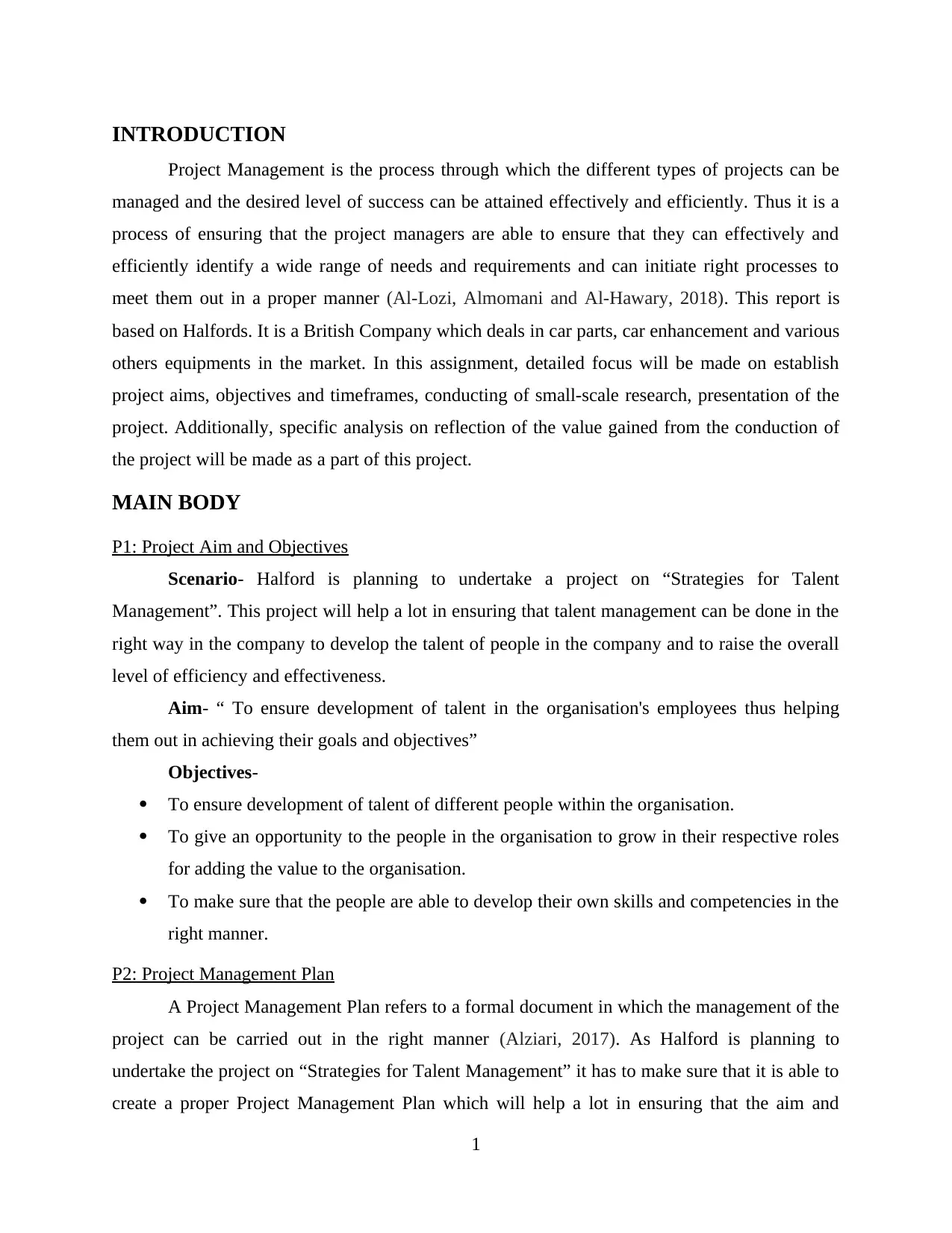
INTRODUCTION
Project Management is the process through which the different types of projects can be
managed and the desired level of success can be attained effectively and efficiently. Thus it is a
process of ensuring that the project managers are able to ensure that they can effectively and
efficiently identify a wide range of needs and requirements and can initiate right processes to
meet them out in a proper manner (Al-Lozi, Almomani and Al-Hawary, 2018). This report is
based on Halfords. It is a British Company which deals in car parts, car enhancement and various
others equipments in the market. In this assignment, detailed focus will be made on establish
project aims, objectives and timeframes, conducting of small-scale research, presentation of the
project. Additionally, specific analysis on reflection of the value gained from the conduction of
the project will be made as a part of this project.
MAIN BODY
P1: Project Aim and Objectives
Scenario- Halford is planning to undertake a project on “Strategies for Talent
Management”. This project will help a lot in ensuring that talent management can be done in the
right way in the company to develop the talent of people in the company and to raise the overall
level of efficiency and effectiveness.
Aim- “ To ensure development of talent in the organisation's employees thus helping
them out in achieving their goals and objectives”
Objectives-
To ensure development of talent of different people within the organisation.
To give an opportunity to the people in the organisation to grow in their respective roles
for adding the value to the organisation.
To make sure that the people are able to develop their own skills and competencies in the
right manner.
P2: Project Management Plan
A Project Management Plan refers to a formal document in which the management of the
project can be carried out in the right manner (Alziari, 2017). As Halford is planning to
undertake the project on “Strategies for Talent Management” it has to make sure that it is able to
create a proper Project Management Plan which will help a lot in ensuring that the aim and
1
Project Management is the process through which the different types of projects can be
managed and the desired level of success can be attained effectively and efficiently. Thus it is a
process of ensuring that the project managers are able to ensure that they can effectively and
efficiently identify a wide range of needs and requirements and can initiate right processes to
meet them out in a proper manner (Al-Lozi, Almomani and Al-Hawary, 2018). This report is
based on Halfords. It is a British Company which deals in car parts, car enhancement and various
others equipments in the market. In this assignment, detailed focus will be made on establish
project aims, objectives and timeframes, conducting of small-scale research, presentation of the
project. Additionally, specific analysis on reflection of the value gained from the conduction of
the project will be made as a part of this project.
MAIN BODY
P1: Project Aim and Objectives
Scenario- Halford is planning to undertake a project on “Strategies for Talent
Management”. This project will help a lot in ensuring that talent management can be done in the
right way in the company to develop the talent of people in the company and to raise the overall
level of efficiency and effectiveness.
Aim- “ To ensure development of talent in the organisation's employees thus helping
them out in achieving their goals and objectives”
Objectives-
To ensure development of talent of different people within the organisation.
To give an opportunity to the people in the organisation to grow in their respective roles
for adding the value to the organisation.
To make sure that the people are able to develop their own skills and competencies in the
right manner.
P2: Project Management Plan
A Project Management Plan refers to a formal document in which the management of the
project can be carried out in the right manner (Alziari, 2017). As Halford is planning to
undertake the project on “Strategies for Talent Management” it has to make sure that it is able to
create a proper Project Management Plan which will help a lot in ensuring that the aim and
1
Paraphrase This Document
Need a fresh take? Get an instant paraphrase of this document with our AI Paraphraser
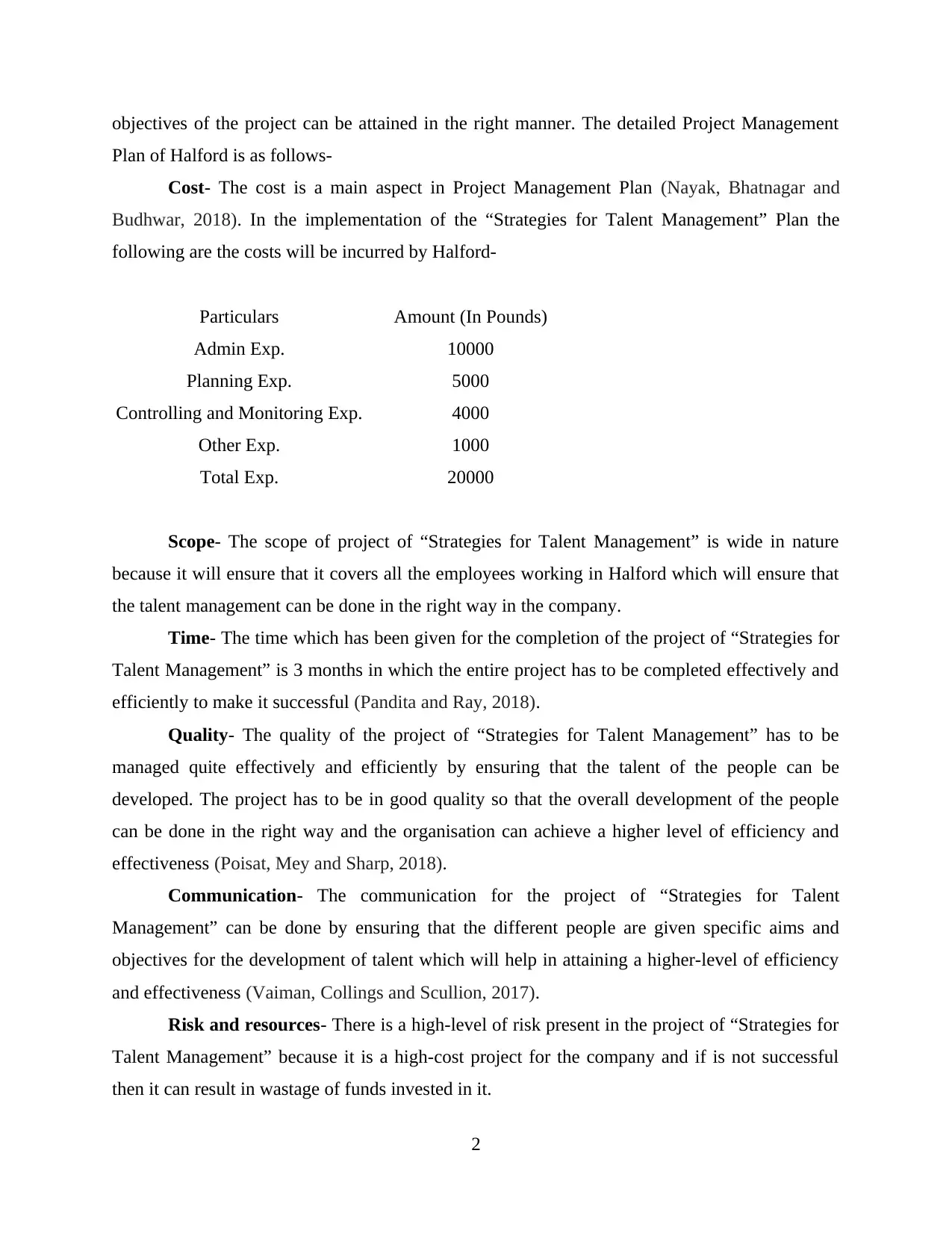
objectives of the project can be attained in the right manner. The detailed Project Management
Plan of Halford is as follows-
Cost- The cost is a main aspect in Project Management Plan (Nayak, Bhatnagar and
Budhwar, 2018). In the implementation of the “Strategies for Talent Management” Plan the
following are the costs will be incurred by Halford-
Particulars Amount (In Pounds)
Admin Exp. 10000
Planning Exp. 5000
Controlling and Monitoring Exp. 4000
Other Exp. 1000
Total Exp. 20000
Scope- The scope of project of “Strategies for Talent Management” is wide in nature
because it will ensure that it covers all the employees working in Halford which will ensure that
the talent management can be done in the right way in the company.
Time- The time which has been given for the completion of the project of “Strategies for
Talent Management” is 3 months in which the entire project has to be completed effectively and
efficiently to make it successful (Pandita and Ray, 2018).
Quality- The quality of the project of “Strategies for Talent Management” has to be
managed quite effectively and efficiently by ensuring that the talent of the people can be
developed. The project has to be in good quality so that the overall development of the people
can be done in the right way and the organisation can achieve a higher level of efficiency and
effectiveness (Poisat, Mey and Sharp, 2018).
Communication- The communication for the project of “Strategies for Talent
Management” can be done by ensuring that the different people are given specific aims and
objectives for the development of talent which will help in attaining a higher-level of efficiency
and effectiveness (Vaiman, Collings and Scullion, 2017).
Risk and resources- There is a high-level of risk present in the project of “Strategies for
Talent Management” because it is a high-cost project for the company and if is not successful
then it can result in wastage of funds invested in it.
2
Plan of Halford is as follows-
Cost- The cost is a main aspect in Project Management Plan (Nayak, Bhatnagar and
Budhwar, 2018). In the implementation of the “Strategies for Talent Management” Plan the
following are the costs will be incurred by Halford-
Particulars Amount (In Pounds)
Admin Exp. 10000
Planning Exp. 5000
Controlling and Monitoring Exp. 4000
Other Exp. 1000
Total Exp. 20000
Scope- The scope of project of “Strategies for Talent Management” is wide in nature
because it will ensure that it covers all the employees working in Halford which will ensure that
the talent management can be done in the right way in the company.
Time- The time which has been given for the completion of the project of “Strategies for
Talent Management” is 3 months in which the entire project has to be completed effectively and
efficiently to make it successful (Pandita and Ray, 2018).
Quality- The quality of the project of “Strategies for Talent Management” has to be
managed quite effectively and efficiently by ensuring that the talent of the people can be
developed. The project has to be in good quality so that the overall development of the people
can be done in the right way and the organisation can achieve a higher level of efficiency and
effectiveness (Poisat, Mey and Sharp, 2018).
Communication- The communication for the project of “Strategies for Talent
Management” can be done by ensuring that the different people are given specific aims and
objectives for the development of talent which will help in attaining a higher-level of efficiency
and effectiveness (Vaiman, Collings and Scullion, 2017).
Risk and resources- There is a high-level of risk present in the project of “Strategies for
Talent Management” because it is a high-cost project for the company and if is not successful
then it can result in wastage of funds invested in it.
2
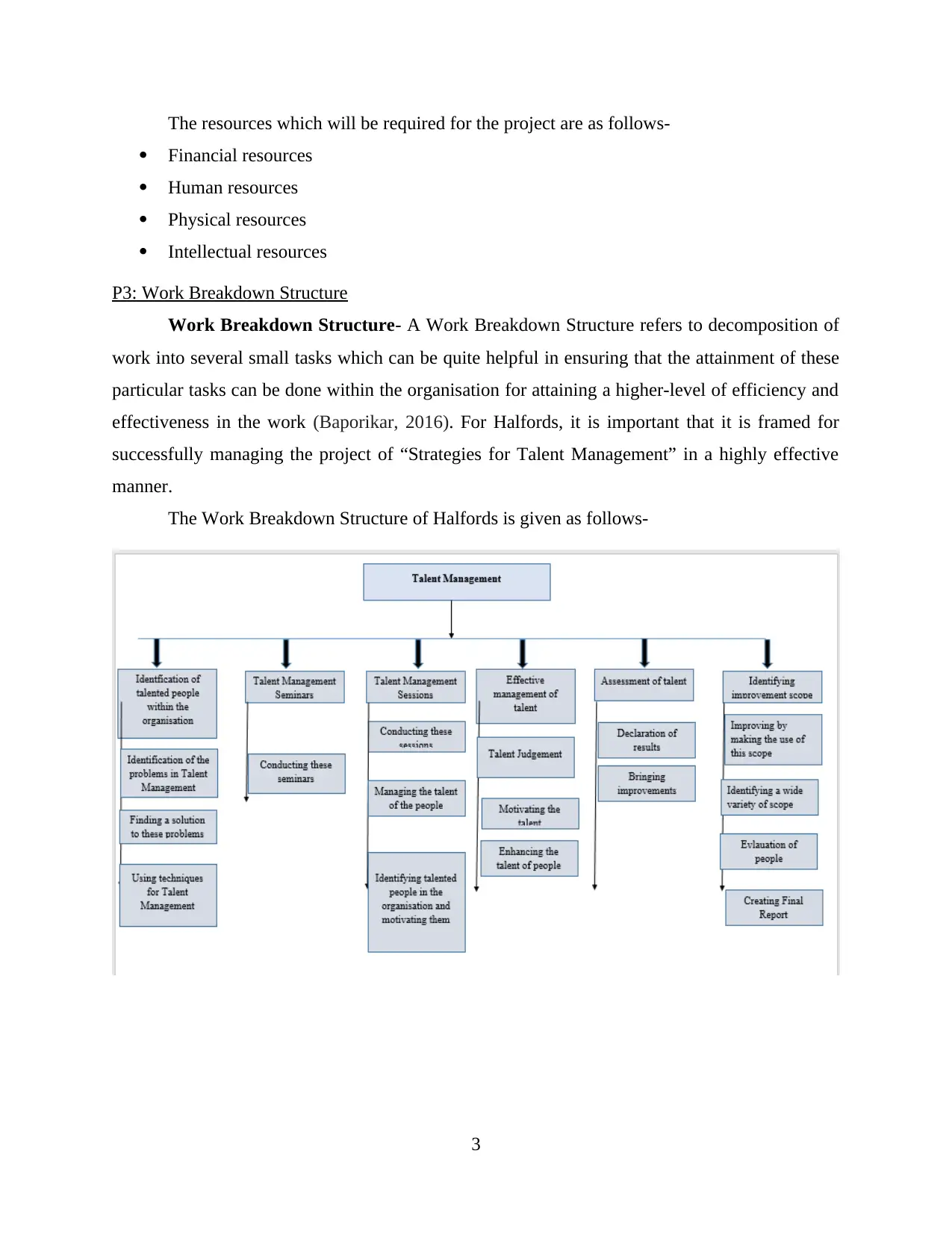
The resources which will be required for the project are as follows-
Financial resources
Human resources
Physical resources
Intellectual resources
P3: Work Breakdown Structure
Work Breakdown Structure- A Work Breakdown Structure refers to decomposition of
work into several small tasks which can be quite helpful in ensuring that the attainment of these
particular tasks can be done within the organisation for attaining a higher-level of efficiency and
effectiveness in the work (Baporikar, 2016). For Halfords, it is important that it is framed for
successfully managing the project of “Strategies for Talent Management” in a highly effective
manner.
The Work Breakdown Structure of Halfords is given as follows-
3
Financial resources
Human resources
Physical resources
Intellectual resources
P3: Work Breakdown Structure
Work Breakdown Structure- A Work Breakdown Structure refers to decomposition of
work into several small tasks which can be quite helpful in ensuring that the attainment of these
particular tasks can be done within the organisation for attaining a higher-level of efficiency and
effectiveness in the work (Baporikar, 2016). For Halfords, it is important that it is framed for
successfully managing the project of “Strategies for Talent Management” in a highly effective
manner.
The Work Breakdown Structure of Halfords is given as follows-
3
⊘ This is a preview!⊘
Do you want full access?
Subscribe today to unlock all pages.

Trusted by 1+ million students worldwide
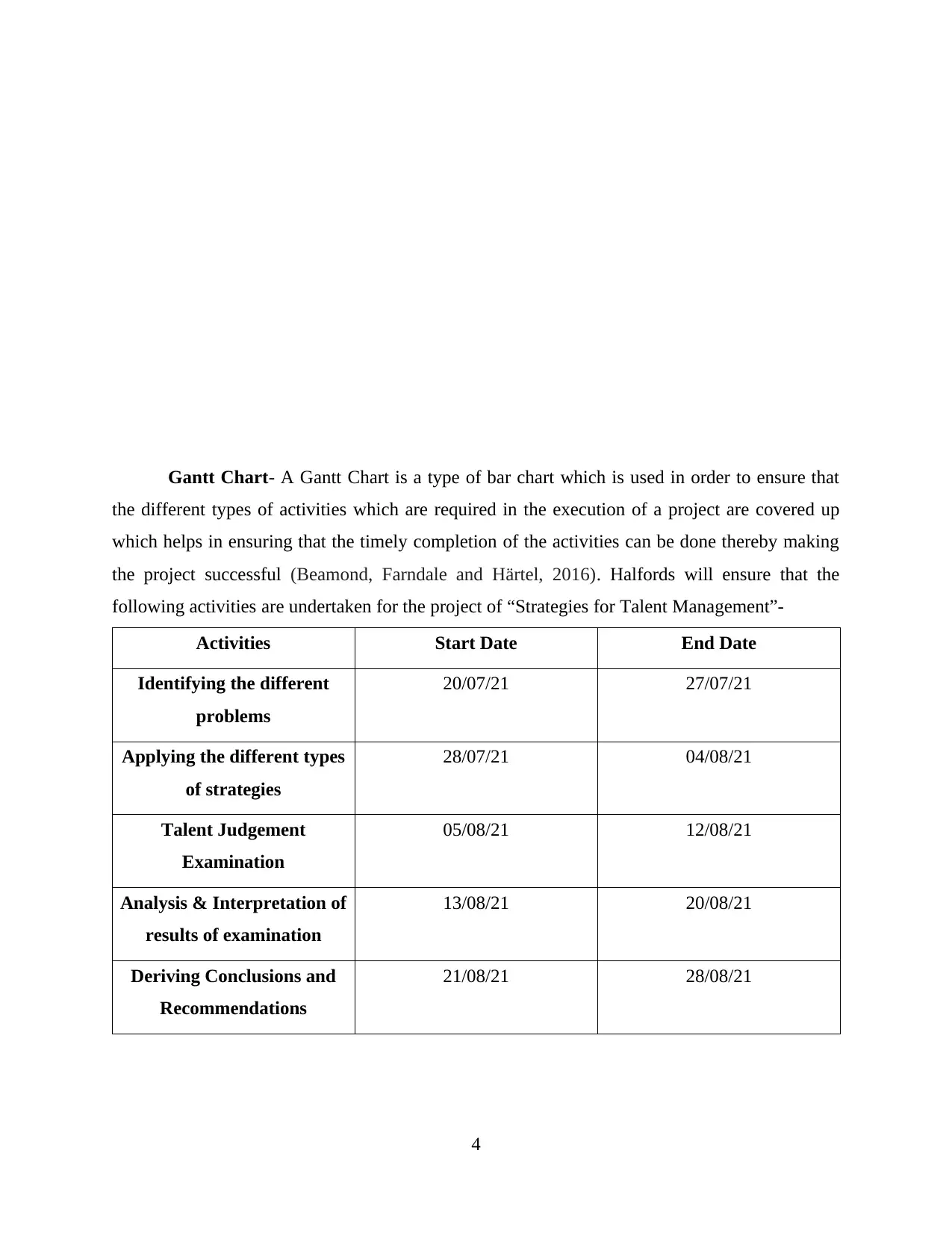
Gantt Chart- A Gantt Chart is a type of bar chart which is used in order to ensure that
the different types of activities which are required in the execution of a project are covered up
which helps in ensuring that the timely completion of the activities can be done thereby making
the project successful (Beamond, Farndale and Härtel, 2016). Halfords will ensure that the
following activities are undertaken for the project of “Strategies for Talent Management”-
Activities Start Date End Date
Identifying the different
problems
20/07/21 27/07/21
Applying the different types
of strategies
28/07/21 04/08/21
Talent Judgement
Examination
05/08/21 12/08/21
Analysis & Interpretation of
results of examination
13/08/21 20/08/21
Deriving Conclusions and
Recommendations
21/08/21 28/08/21
4
the different types of activities which are required in the execution of a project are covered up
which helps in ensuring that the timely completion of the activities can be done thereby making
the project successful (Beamond, Farndale and Härtel, 2016). Halfords will ensure that the
following activities are undertaken for the project of “Strategies for Talent Management”-
Activities Start Date End Date
Identifying the different
problems
20/07/21 27/07/21
Applying the different types
of strategies
28/07/21 04/08/21
Talent Judgement
Examination
05/08/21 12/08/21
Analysis & Interpretation of
results of examination
13/08/21 20/08/21
Deriving Conclusions and
Recommendations
21/08/21 28/08/21
4
Paraphrase This Document
Need a fresh take? Get an instant paraphrase of this document with our AI Paraphraser
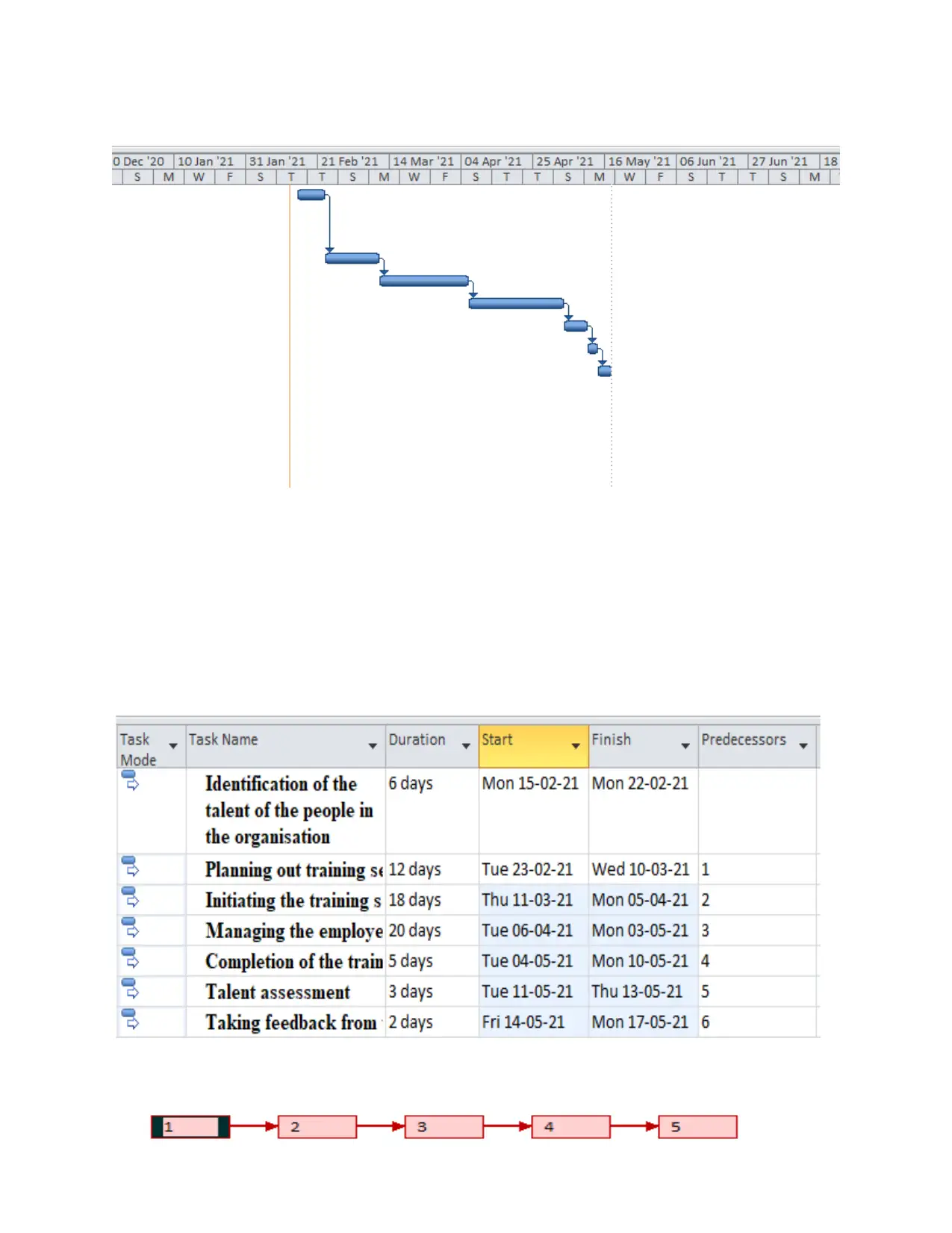
5
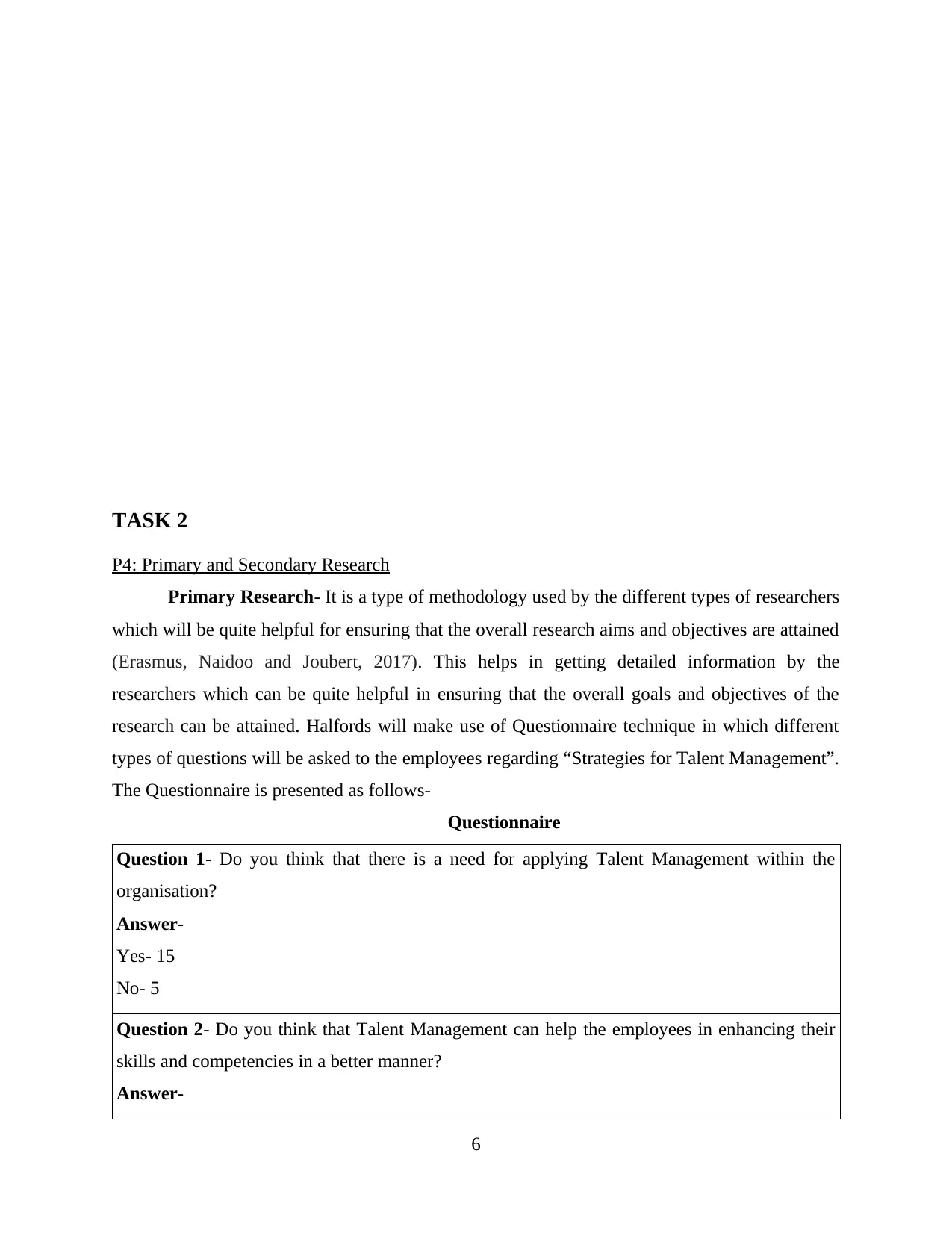
TASK 2
P4: Primary and Secondary Research
Primary Research- It is a type of methodology used by the different types of researchers
which will be quite helpful for ensuring that the overall research aims and objectives are attained
(Erasmus, Naidoo and Joubert, 2017). This helps in getting detailed information by the
researchers which can be quite helpful in ensuring that the overall goals and objectives of the
research can be attained. Halfords will make use of Questionnaire technique in which different
types of questions will be asked to the employees regarding “Strategies for Talent Management”.
The Questionnaire is presented as follows-
Questionnaire
Question 1- Do you think that there is a need for applying Talent Management within the
organisation?
Answer-
Yes- 15
No- 5
Question 2- Do you think that Talent Management can help the employees in enhancing their
skills and competencies in a better manner?
Answer-
6
P4: Primary and Secondary Research
Primary Research- It is a type of methodology used by the different types of researchers
which will be quite helpful for ensuring that the overall research aims and objectives are attained
(Erasmus, Naidoo and Joubert, 2017). This helps in getting detailed information by the
researchers which can be quite helpful in ensuring that the overall goals and objectives of the
research can be attained. Halfords will make use of Questionnaire technique in which different
types of questions will be asked to the employees regarding “Strategies for Talent Management”.
The Questionnaire is presented as follows-
Questionnaire
Question 1- Do you think that there is a need for applying Talent Management within the
organisation?
Answer-
Yes- 15
No- 5
Question 2- Do you think that Talent Management can help the employees in enhancing their
skills and competencies in a better manner?
Answer-
6
⊘ This is a preview!⊘
Do you want full access?
Subscribe today to unlock all pages.

Trusted by 1+ million students worldwide
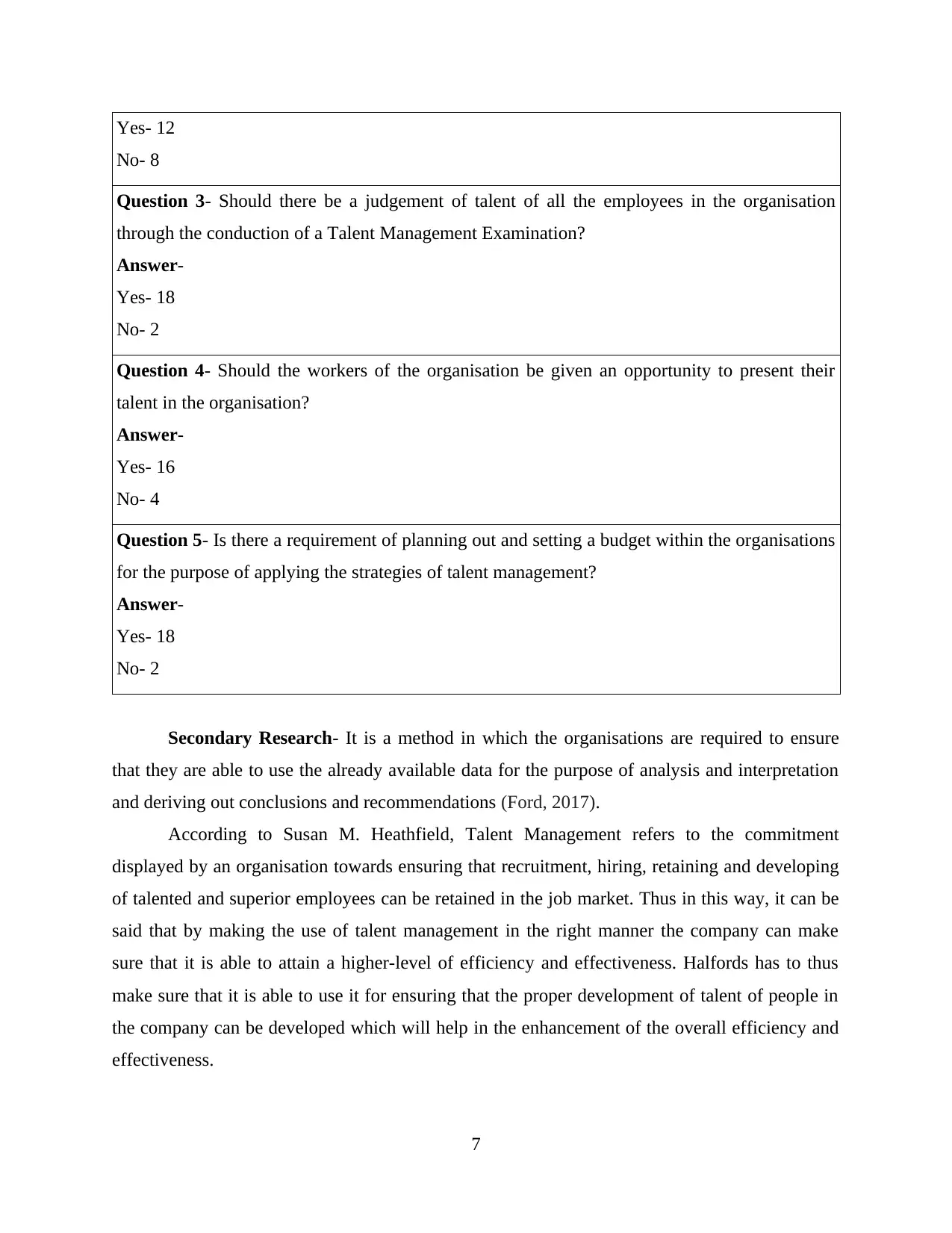
Yes- 12
No- 8
Question 3- Should there be a judgement of talent of all the employees in the organisation
through the conduction of a Talent Management Examination?
Answer-
Yes- 18
No- 2
Question 4- Should the workers of the organisation be given an opportunity to present their
talent in the organisation?
Answer-
Yes- 16
No- 4
Question 5- Is there a requirement of planning out and setting a budget within the organisations
for the purpose of applying the strategies of talent management?
Answer-
Yes- 18
No- 2
Secondary Research- It is a method in which the organisations are required to ensure
that they are able to use the already available data for the purpose of analysis and interpretation
and deriving out conclusions and recommendations (Ford, 2017).
According to Susan M. Heathfield, Talent Management refers to the commitment
displayed by an organisation towards ensuring that recruitment, hiring, retaining and developing
of talented and superior employees can be retained in the job market. Thus in this way, it can be
said that by making the use of talent management in the right manner the company can make
sure that it is able to attain a higher-level of efficiency and effectiveness. Halfords has to thus
make sure that it is able to use it for ensuring that the proper development of talent of people in
the company can be developed which will help in the enhancement of the overall efficiency and
effectiveness.
7
No- 8
Question 3- Should there be a judgement of talent of all the employees in the organisation
through the conduction of a Talent Management Examination?
Answer-
Yes- 18
No- 2
Question 4- Should the workers of the organisation be given an opportunity to present their
talent in the organisation?
Answer-
Yes- 16
No- 4
Question 5- Is there a requirement of planning out and setting a budget within the organisations
for the purpose of applying the strategies of talent management?
Answer-
Yes- 18
No- 2
Secondary Research- It is a method in which the organisations are required to ensure
that they are able to use the already available data for the purpose of analysis and interpretation
and deriving out conclusions and recommendations (Ford, 2017).
According to Susan M. Heathfield, Talent Management refers to the commitment
displayed by an organisation towards ensuring that recruitment, hiring, retaining and developing
of talented and superior employees can be retained in the job market. Thus in this way, it can be
said that by making the use of talent management in the right manner the company can make
sure that it is able to attain a higher-level of efficiency and effectiveness. Halfords has to thus
make sure that it is able to use it for ensuring that the proper development of talent of people in
the company can be developed which will help in the enhancement of the overall efficiency and
effectiveness.
7
Paraphrase This Document
Need a fresh take? Get an instant paraphrase of this document with our AI Paraphraser
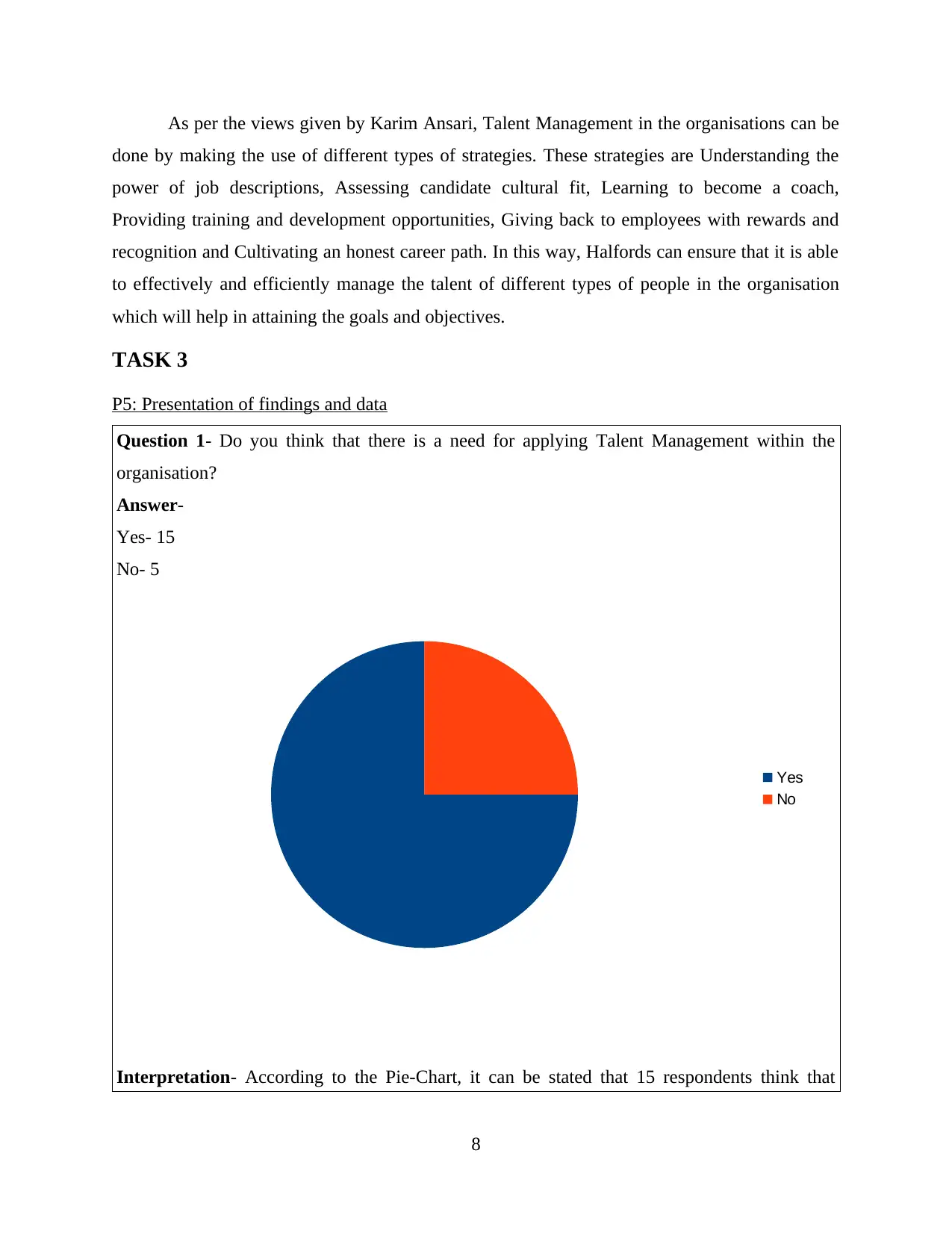
As per the views given by Karim Ansari, Talent Management in the organisations can be
done by making the use of different types of strategies. These strategies are Understanding the
power of job descriptions, Assessing candidate cultural fit, Learning to become a coach,
Providing training and development opportunities, Giving back to employees with rewards and
recognition and Cultivating an honest career path. In this way, Halfords can ensure that it is able
to effectively and efficiently manage the talent of different types of people in the organisation
which will help in attaining the goals and objectives.
TASK 3
P5: Presentation of findings and data
Question 1- Do you think that there is a need for applying Talent Management within the
organisation?
Answer-
Yes- 15
No- 5
Interpretation- According to the Pie-Chart, it can be stated that 15 respondents think that
8
Yes
No
done by making the use of different types of strategies. These strategies are Understanding the
power of job descriptions, Assessing candidate cultural fit, Learning to become a coach,
Providing training and development opportunities, Giving back to employees with rewards and
recognition and Cultivating an honest career path. In this way, Halfords can ensure that it is able
to effectively and efficiently manage the talent of different types of people in the organisation
which will help in attaining the goals and objectives.
TASK 3
P5: Presentation of findings and data
Question 1- Do you think that there is a need for applying Talent Management within the
organisation?
Answer-
Yes- 15
No- 5
Interpretation- According to the Pie-Chart, it can be stated that 15 respondents think that
8
Yes
No
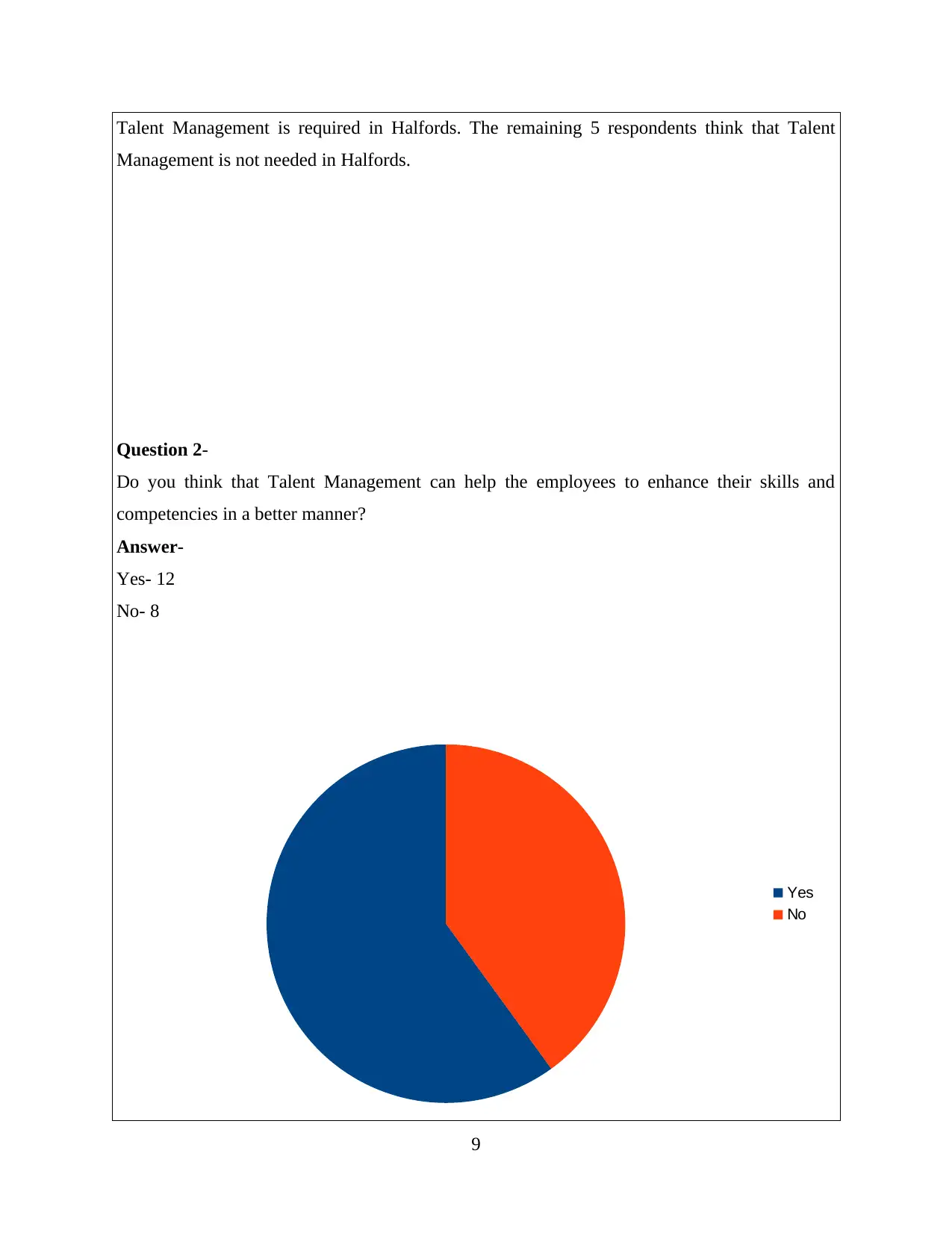
Talent Management is required in Halfords. The remaining 5 respondents think that Talent
Management is not needed in Halfords.
Question 2-
Do you think that Talent Management can help the employees to enhance their skills and
competencies in a better manner?
Answer-
Yes- 12
No- 8
9
Yes
No
Management is not needed in Halfords.
Question 2-
Do you think that Talent Management can help the employees to enhance their skills and
competencies in a better manner?
Answer-
Yes- 12
No- 8
9
Yes
No
⊘ This is a preview!⊘
Do you want full access?
Subscribe today to unlock all pages.

Trusted by 1+ million students worldwide
1 out of 19
Related Documents
Your All-in-One AI-Powered Toolkit for Academic Success.
+13062052269
info@desklib.com
Available 24*7 on WhatsApp / Email
![[object Object]](/_next/static/media/star-bottom.7253800d.svg)
Unlock your academic potential
Copyright © 2020–2025 A2Z Services. All Rights Reserved. Developed and managed by ZUCOL.





